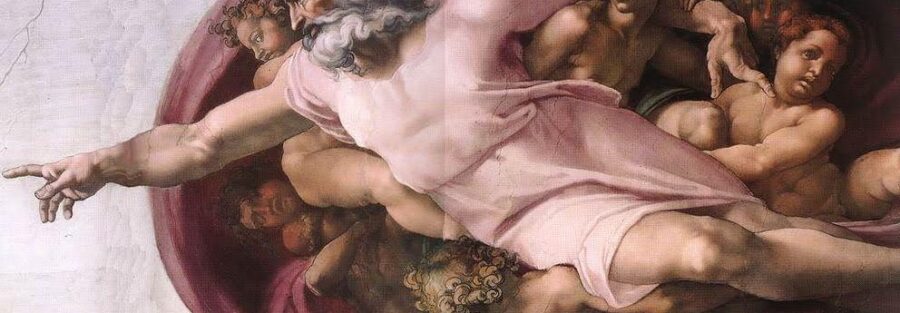THE GENESIS OF HUMANITY: MICHELANGELO’S CREATION OF ADAM IN THE SISTINE CHAPEL

“The greater danger for most of us lies not in setting our aim too high and falling short; but in setting our aim too low and achieving our mark.”-
Michelangelo
THE CREATION OF ADAM

Book of Genesis, which states that “God created man in His own image, in the image of God He created him” (Gen 1:27). In the painting, Adam is depicted lying on the grassy slope, symbolizing the moment just before humanity’s creation. His youthful, muscular body is bent towards the right, with a bland expression, awaiting God’s touch to receive life. His face is shown in profile, with a slim nose and lips, and his body, though adult in form, has an unusually small depiction of his penis. His right arm supports his torso, and his left arm extends toward God’s finger. The overall portrayal highlights Adam’s strength and beauty, yet he appears soulless and passive.
Adam’s small depiction of his penis in the painting reflects ancient Greek ideals, where a small penis was considered more beautiful and elegant. When Italians revisited their classical heritage, they adopted these ancient Greek aesthetic standards in their art.
In the painting, God is depicted on the right side, floating within a red nebulous form, surrounded by smaller beings. His muscular, older male body is shown in profile, with flowing grey hair, a long curved beard, and a light tunic that leaves his limbs exposed. God is reaching out to Adam to give him life, symbolizing the birth of humanity. His right hand extends toward Adam’s finger, while his left hand touches a female figure near an angel. The pose conveys intimacy, showing God not as distant but more accessible, embodying the Holy Trinity.

Theories suggest the female figure inside the red drapery could be Eve or the Virgin Mary, placed near God’s shoulder. She is depicted nude and youthful, with an angel beside her symbolizing the future child of Christ. God’s finger touching the angel links the Creation of Adam to Christ’s future redemption of humanity through the Eucharist.
God is surrounded by seven male angels, three above Him and three near Eve. The angels, depicted as chubby, muscular, and wingless, wear red cloaks and gaze toward Adam. Four angels are positioned around God, while seven more surround Eve. The background features a simple scene with Adam on a green slope and God floating against a blue sky. Four nude figures are shown in the corners.
The similarity between God and Adam’s faces raises questions about who is creating whom. One theory by F.L. Meshberger suggests that the drapery around God resembles the human brain, symbolizing Adam being created from God’s mind. Another theory proposes that the shape of God and the angels resembles a womb and placenta, implying Adam is born, not created.
BIBLIOGRAPHY
- Stockwell, Margaux. 2020. “The Creation of Adam (c.1508 – 1512): Michelangelo’s Astounding Piece.” Singulart. https://www.singulart.com/en/blog/2020/04/15/the-creation-of-adam-c-1508-1512-michaelangelos-astounding-piece/.
- “Art analysis of Michelangelo’s Sistine Chapel Ceiling.” 2022. YouTube. https://www.youtube.com/watch?v=bK01bwChrFY&list=RDLVzPk0Gng2oTM&index=4.
- Wallace, William, and Leo Steinberg. n.d. “Michelangelo’s Creation of Adam – ItalianRenaissance.org.” ItalianRenaissance.org. Accessed May 9, 2023. https://www.italianrenaissance.org/michelangelo-creation-of-adam/.
“What is the Meaning Behind Michelangelo’s Creation of Adam?” n.d. TheCollector. Accessed May 9, 2023. https://www.thecollector.com/michelangelo-creation-of-adam-meaning/.
PHOTOGRAPH
- “File:Creación de Adán.jpg.” n.d. Photograph. Wikimedia Commons. Accessed May 9, 2023. https://commons.wikimedia.org/wiki/File:Creaci%C3%B3n_de_Ad%C3%A1n.jpg.
- “File:Michelangelo, Creation of Adam 04.jpg.” n.d. Photograph. Wikimedia Commons. Accessed May 9, 2023.
https://commons.wikimedia.org/wiki/File:Michelangelo,_Creation_of_Adam_04.jpg.
About the Author:
Author: RAVEENA
I am Graduated with a degree in B.A Programme from the Maitreyi College, Delhi University. I completed a Post-Graduation in the History of Art from the National Museum Institute, New Delhi. In 2024, I completed a six-month internship in the Archaeological Department of the National Museum, New Delhi.




